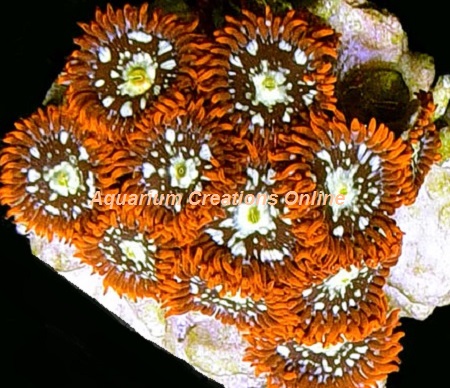Orange Splatter Zoanthid Polyps are an awesome collector zoanthid. The Orange Splatter has bright orange lashes, with black splatters on a cream/white background, and a yellow eye. Like all of our polyps they are aquacultured specimens, many generations removed from the original wild starter colonies. Like all of our polyps they are aquacultured specimens, many generations removed from the original wild starter colonies.
Keeping your parameters at the standard level will help these corals stay happy. Set your salinity between 1.024 and 1.026. Your pH should range around 8.3 and your temperature should stay between 77 and 82 degrees Fahrenheit.
Aggressiveness
Orange Splatter Colony Polyps will continue to spread or colonize nearby rocks, they can be separated from other coral species by providing gaps between the rock aqua-scaping, in order to create a boundary to limit the carpeting or horizontal growth of the Polyps. Proper placement is important when keeping Polyps with other corals, as Polyps will crowd out other corals by stinging them repeatedly as they grown in and around them.
Water flow
They require moderate to strong water flow in order to allow their symbiotic algae zooxanthellae to thrive and produce food for the coral.
Lighting
They require medium to strong lighting (PAR 100-250) to maintain their color. T5's, Metal Halides, or LED's can all grow Zoanthids and Palythoa when the proper PAR levels are provided. We recommend a 14-20K color spectrum for best coloration.
Placement
In the case of Orange Splatter Zoas many hobbyists have had good success by placing them lower in the aquarium in a location that receives strong but filtered lighting. Given time and gradual adjustments, hobbyists should be able to identify the ideal location in which to keep Fire and Ice Zoas in their reef aquarium.
Diet and Feeding
Orange Splatter Zoas receive the vast majority of their nutrition through the symbiotic algae zooxanthellae contained within the coral. They receive other nutrients from dissolved minerals that they filter from the water currents. They will also benefit from the addition of reef supplements containing calcium, magnesium, iodine and trace elements. They can also be periodically offered meaty foods like micro-plankton, baby brine shrimp and other similar items.
Well established reef aquariums with populations of phyto-plankton work best for all varieties of filter feeders, as they are able to supplement their diet with foods filtered from the water column. The addition of reef additives like: calcium, strontium, iodine and trace elements along with occasional feedings of micro-plankton and similar foodstuffs should allow for the best possible growth rate.
Caution
Some Zoanthid's secrete a poison through their mucus known as palytoxin. Palytoxin is extremely dangerous, and it affects humans in a very adverse way. The toxin enters the system via open wounds, ingestion, and injection. What is highly recommended with these Zoanthids and Palythoa when handling, is to wear protective gear, such as gloves and goggles, and to use tongs or tweezers to avoid any contact with skin.
|



